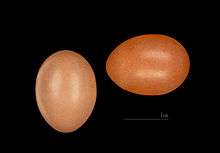Cetti's warbler
| Cetti's warbler | |
|---|---|
 | |
| Cetti's warbler by the Kalloni east river, Lesvos, Greece. | |
| Scientific classification | |
| Kingdom: | Animalia |
| Phylum: | Chordata |
| Class: | Aves |
| Order: | Passeriformes |
| Family: | Cettiidae |
| Genus: | Cettia |
| Species: | C. cetti |
| Binomial name | |
| Cettia cetti (Temminck, 1820) | |

Cetti's warbler /ˈtʃɛti/, Cettia cetti, is an Old World warbler. It is a small, brown bush-warbler which breeds in southern and central Europe,[2] north-west Africa and east southern temperate Asia as far as Afghanistan and north-west Pakistan. The bird is named after the 18th century Italian zoologist, Francesco Cetti.[3] This species is very difficult to see because of its skulking habits.[4]
Population
The number of Cetti’s warblers has greatly increased across Europe since 1990.[5] The current population of Cetti's warblers in Europe is estimated to be about 600,000-1,600,000 breeding pairs.[6] The populations in Italy and Turkey are known to be stable or increasing. The exception to the general positive European population trend is Greece, where the population decreased slightly between 1990 and 2000. However, overall, Cetti’s warblers are evaluated as secure.[7] The Cetti's warbler was first recorded in the United Kingdom in 1961.[8] The UK population of Cetti's warblers fell by over a third between 1984 and 1986. However, populations in milder regions continued to grow.[9]
Description
The Cetti’s warbler is approximately 13–14 cm (5.1–5.5 in) from bill to tail.[10] The male weighs 15 g (0.53 oz) and the female 12 g (0.42 oz).[11] Cetti’s warblers have a rounded head with a narrow pale grey stripe arching over conspicuous black eyes, and short, rounded wings. They are a rich chestnut or dark reddish-brown colour on the upperparts. They are pale grey on the throat and stomach, with a longer and broader tail than many other warblers. Both sexes looks alike, but males are 26% to 32% heavier than females with a wing-length 11.2% to 13.% longer. The male has a wing longer than 60 mm; the female has a wing shorter than 55 mm. The birds can be aged by their plumage; juveniles look similar to adults but have fresh plumage and two dark or dark grey spots on the tongue.[12][13] Cetti's warbler is unusual among passerine birds in having ten tail feathers (rectrices) rather than the usual twelve.[14]
Behaviour
Cetti's warblers signal their presence with loud song.[10] During the summer, the males spend most of their time establishing their territories. While doing this, they spend little amount of time caring for the eggs or young. Afterwards, the males usually attract more than one female to their territory.[15] Their song plays an important role. Cetti's warbler songs are distinct, come in loud bursts, and have a unique structure that allows them to avoid mating with other species.[16]
Habitat and food
The Cetti's warbler usually inhabits damp areas including ponds, lakes, marshes and rivers. It is insectivorous. They prey on arthropods such as small, soft-bodied insects and larvae. Cetti's warblers prefer tiny insects because they can digest them faster.[17]
References
- ↑ BirdLife International (2012). "Cettia cetti". IUCN Red List of Threatened Species. Version 2013.2. International Union for Conservation of Nature. Retrieved 26 November 2013.
- ↑ Robinson, Robert A.; Freemen, Stephen N.; Balmer, Dawn E.; Grantham, Mark J. (2007). "Cetti's Warbler Cettia cetti: analysis of an expanding population". BTO. 54: 230–235. doi:10.1080/00063650709461479.
- ↑ Jobling, James A (2010). The Helm Dictionary of Scientific Bird Names. London: Christopher Helm. p. 97. ISBN 978-1-4081-2501-4.
- ↑ Seago, Michael J (31 Oct 2012). "Cetti's Warbler".
- ↑ "Trends of common birds in Europe, 2010 update". European Bird Census Council. Retrieved 1 Nov 2012.
- ↑ "Species: Cetti's Warbler". BirdLife International. Retrieved 1 Nov 2012.
- ↑ "Cettia cetti – Cetti's Warbler" (PDF). BirdLife International. Retrieved 2 Nov 2012.
- ↑ "BTO Report: Cetti's Warbler". British Trust for Ornithology. Retrieved 1 Nov 2012.
- ↑ "Breeding Birds of the Wider Countryside: Cetti's Warbler". British Trust for Ornithology. Retrieved 1 Nov 2012.
- 1 2 "The RSPB: Cetti's Warbler". 1 Nov 2012.
- ↑ "BTO BirdFacts: Cetti's Warbler". Retrieved 21 July 2015.
- ↑ Colin J., Bibby; Thomas, Derek K. (1984). "Sexual dimorphism in size, moult and movements of Cetti's Warbler Cettia cetti". Bird Study. 31 (1): 28–34. doi:10.1080/00063658409476811.
- ↑ Blasco-Zumeta, Javier; Herinze, Gerd Michael. "Cetti's Warbler". Laboratorio Virtual Ibercaja: 1–5.
- ↑ Svensson, Lars (1992). Identification Guide to European Passerines (4th ed.). Stockholm: L. Svensson. p. 156. ISBN 91-630-1118-2.
- ↑ "Bird Guides-Cetti's Warbler". Retrieved 31 Oct 2012.
- ↑ Hamao, Shoji; Veluz, Maria J. S.; Saitoh, Takema; Nishiumi, Isao (June 2008). "Phylogenetic relationship and song differences between closely related bush warblers (Cettia seebohmi and C. diphone". The Wilson Journal of Ornithology. 120 (2): 268–276. doi:10.1676/07-039.1.
- ↑ Molina, Javier; Hodar, José A.; Camacho, Ismael (1998). "Diet of Cetti's warblers Cettia cetti (Temmink, 1820) in a locality of southern Spain" (PDF). Ardeolo. 45 (2): 217–220.
External links
| Wikimedia Commons has media related to Cettia cetti. |
